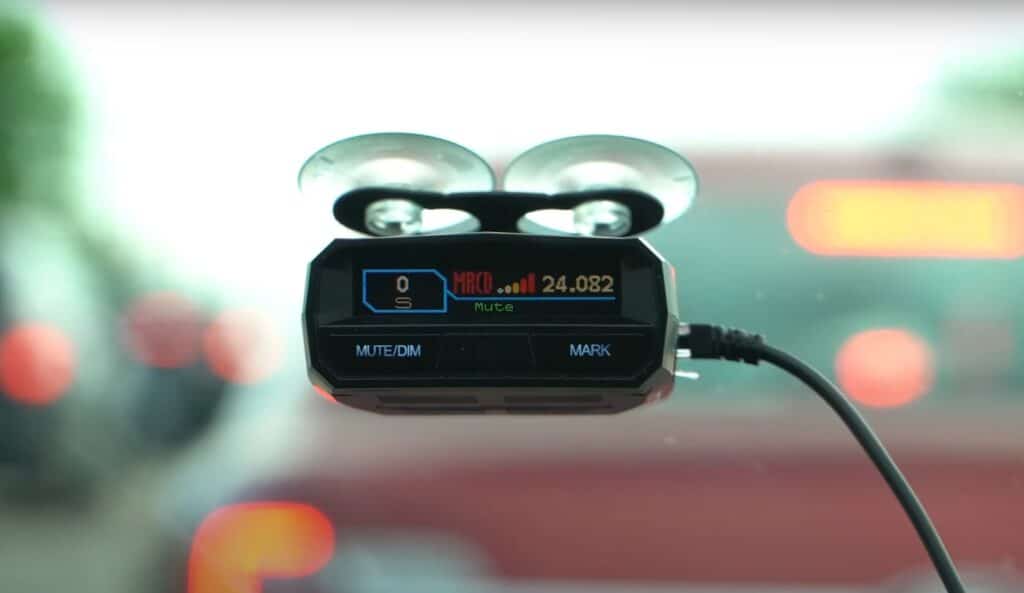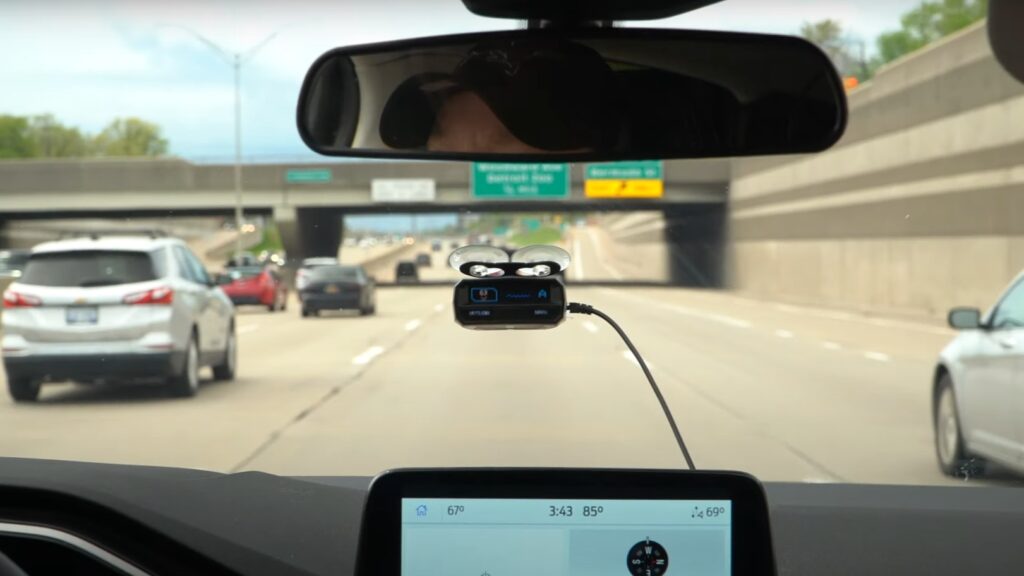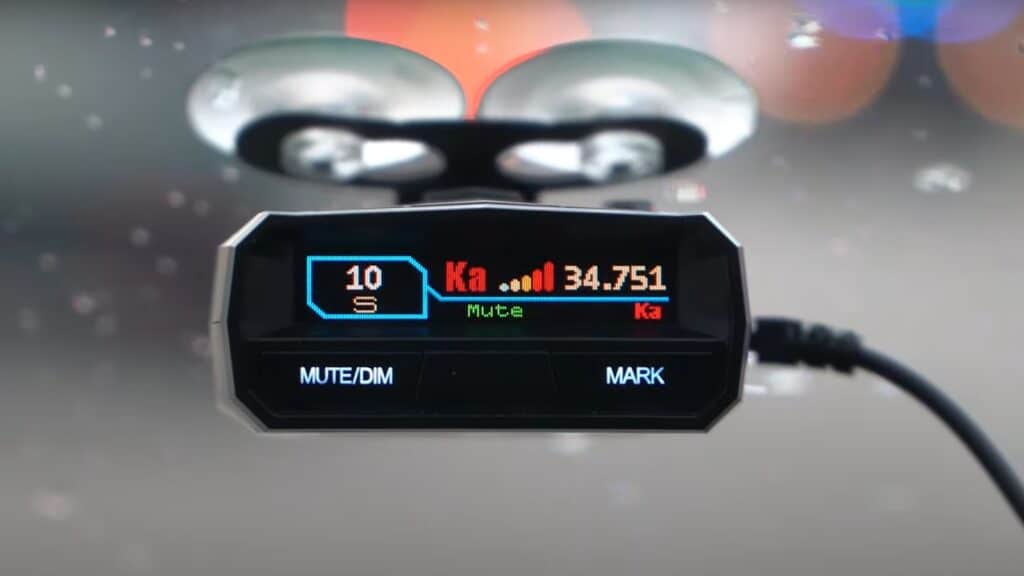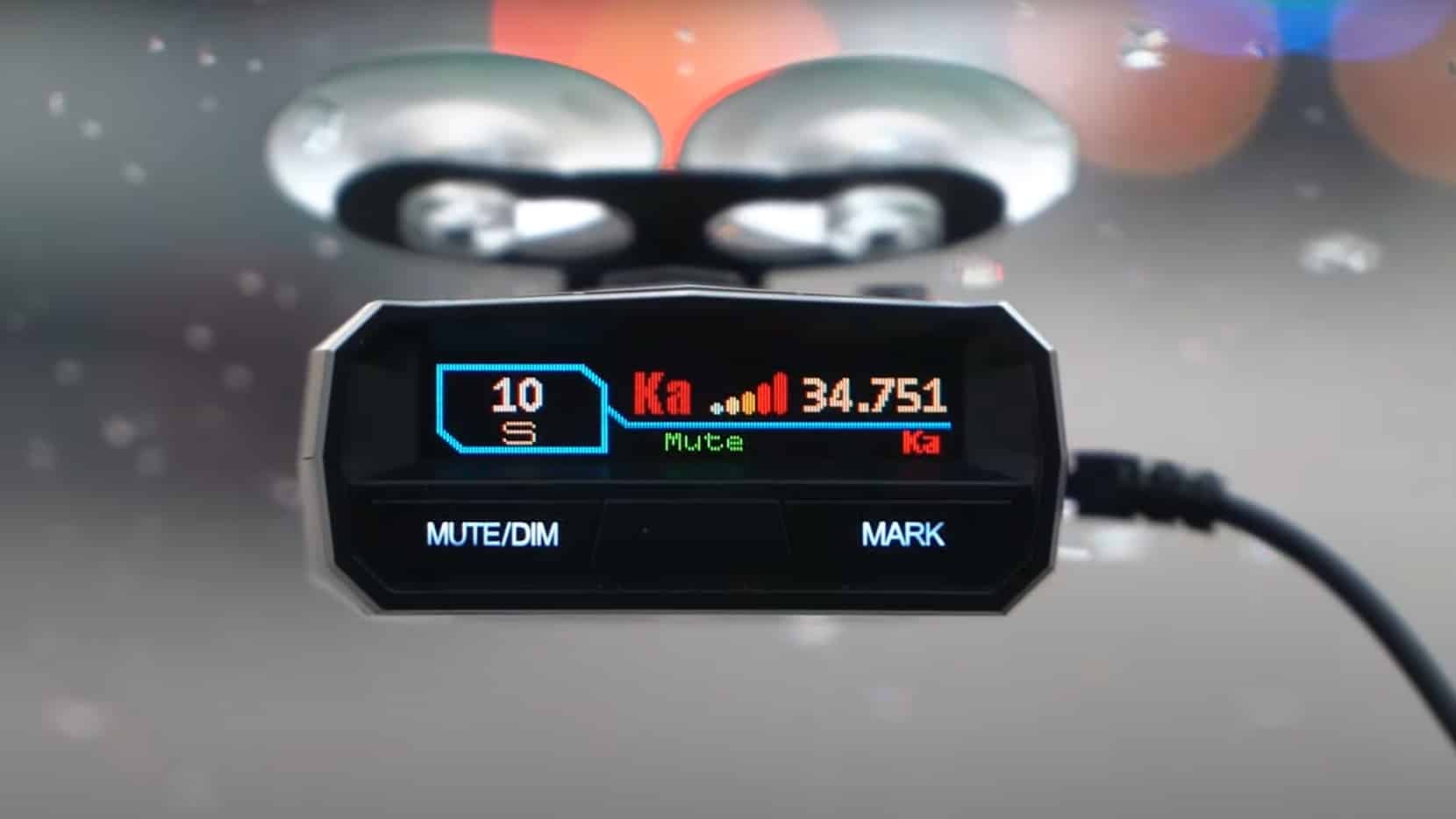Affordable Radar Detector Offers Long Range Detection, Auto Sensitivity Mode & Speed Camera Alerts

Affiliate Disclosure: As an Amazon Associate, Automoblog earns from qualifying purchases. Commissions from Amazon and other affiliate partners come to us at no additional cost to you when making a purchase via this page. We bought the Uniden R4 here with our own money. See our Privacy Policy to learn more.
Uniden R4 Crash Course
- As the successor to the Uniden R3, the R4 offers better false alert filtering, Gatso detection, and two Low Noise Amplifiers (LNAs) to increase the overall detection range.
- Key features include an Auto Sensitivity mode, Auto Mute Memory function, and a Memory Quota bank.
- The Uniden R4 is a good pick if you want to buy your first radar detector but don’t want to spend too much. Not counting any deals or specials, the R4 generally retails in the neighborhood of about $400.
Our Review Process for Radar Detectors
Automoblog is a member of the Radar Detector and Countermeasures Forum to ensure truth and accountability when covering radar detectors.
Whether we receive a radar detector from a manufacturer to review or purchase it with our own money, there are four main points we consider, listed below. Our primary driving areas with any radar detector include the Detroit metro and the Ohio Turnpike.
Uniden R4 Summary
The R4 is the updated version of the popular Uniden R3 radar detector. Although we still regularly drive with the R3 around metro Detroit, the R4 is a welcome addition to our radar detector arsenal, offering solid performance for the dollar.
Complete with an all-new platform, the Uniden R4 offers better false alert filtering, Gatso detection, and two Low Noise Amplifiers (LNAs) to increase the overall range compared to the R3. In effect, the R4 took everything that was good about the R3 and dialed it up.
The Uniden R4 is one of the best radar detectors today and is our top pick for smaller towns and communities. Although we own more feature-intensive radar detectors, like the Escort MAX 360c MKII and both the Uniden R7 and Uniden R8, the R4’s capabilities are plenty for us in the suburbs of Detroit. The R4 offers trustworthy performance in these areas of Michigan without the higher price tag of a radar detector with more bells and whistles.
In this Uniden R4 review, we will cover the features and walk through the settings menu. We also share further insight on why we like the R4 in smaller towns but how it’s still a good companion if you do live in a bigger city.
What’s In The Box?
The R4 comes with a 12V DC power cord with an RJ11 connector, hook and loop tape for dashboard mounting, and an owner’s manual. Included are two different windshield mounting brackets. There is a larger single suction cup bracket and a bracket with two smaller suction cups. Uniden includes a carrying case for the R4 as well.
Uniden R4: Settings & Features
The Uniden R4 is built on an all-new platform, giving it an advantage over the R3 in terms of detection range and available features.
For example, the R4 has an Auto Mute Memory (i.e., auto lockouts) function that automatically locks out false alert locations (grocery stores, shopping plazas, and so on) along your daily route. The R4’s new platform houses dual LNAs to detect radar sources from farther away than the R3 and will detect Gatso radar used by the latest speed cameras.
Regarding the R4’s new platform, a good comparison is a vehicle platform, or rather, the architecture and chassis. Every vehicle has a “platform” on which it’s manufactured. Imagine the difference between a vehicle built today and a decade ago. The newer vehicle will be safer, more fuel-efficient, ride and handle better, and have more tech features. The updated architecture, or platform, allows such things to come to fruition.
The same analogy can be applied to the Uniden R4 and R3, just a little smaller.
Radar & Laser Protection
The Uniden R4 will alert you to X, K, and Ka radar bands and laser (LiDAR) guns. Typical of all Uniden radar detectors, the R4 has excellent long-range detection.
We have X bands turned off to minimize false alerts, but we have seen law enforcement in the Downriver communities south of Detroit use instant-on K bands. As such, we are hesitant to have the R4 ignore K bands outright, so we still have them switched on in the settings menu.
This is something to be mindful of no matter which brand of radar detector you own or are considering buying. Where you live and where you most often drive will determine the best settings for your radar detector. While it’s likely that most K bands are false, not all of them will be – and in a case like ours, you may drive in an area where law enforcement still relies on K band.
With the Uniden R4, when it comes to switching off certain radar bands (like X bands in our case), sensitivity modes, and segmentation filters (covered more below), let where you drive determine your settings.
MRCD, MRCT, RT3 & RT4 Detection
The R4 detects POP transmissions, MRCD, MRCT, RT3, and RT4, with the latter two (RT3 and RT4) being the separate frequency ranges of Gatso radar used by the latest speed cameras.
When warning you of an upcoming red light or speed camera, the R4 will show traffic light or camera icons and the corresponding distance (in feet) to the alert.
A selling point of the Uniden R4 is its ability to alert you to a wide variety of radar sources, from patrol cars and speed traps to traffic cameras and other photo enforcement devices. Although we like the R4 for driving in smaller towns and rural areas, it’s also well-suited for populated locales where you may be more apt to see a red light camera or encounter speed camera alerts.

Sensitivity Modes
The Uniden R4 has a City and Highway mode. In City mode, X and K band sensitivity is reduced to prevent false alerts, while Ka bands stay at full sensitivity. In Highway mode, all bands go to full sensitivity to give you the most reaction time on the open road. You can further optimize the R4’s sensitivity levels through the Advanced Mode.
The Uniden R4 has an Auto Sensitivity mode, essentially a speed-dependent mode that switches back and forth between City and Highway at a pre-set speed.
In the settings menu, look for “Auto City Speed,” where you can set the R4’s switching point between City and Highway in 5 mph increments between 10 and 60 mph.
Here in Detroit, we have the threshold at its max of 60 mph, meaning the R4 doesn’t switch to Highway mode until we exceed that speed. There are roads in the Detroit metro, like Telegraph Road or M-10, where you are still in the city but moving at a higher speed limit. If you use the Auto Sensitivity mode, it’s best to set the switching point between City and Highway based on where you live.
The R4’s Auto Sensitivity mode is convenient, no matter where you drive. It’s a “set it and forget it” type of feature that allows you to stay focused on the road while the R4 handles the switch between City and Highway modes.

Segmentation Filters
You can experiment with the K and Ka filters in the settings menu, including a segmentation filter.
With K band segmentation, the R4 offers three settings: Wide, Narrow, and Extended. Wide and Narrow scan for K band radar guns used in the U.S. only, although Narrow does not scan as much of the available frequency range as Wide. Extended increases the frequency scanning range for K band radar guns to its maximum.
Here in metro Detroit, we are okay with setting the R4 to K Narrow, opening it up a bit to K Wide when we travel south into the Downriver communities, where we have verified K band threats visually.
While driving in Detroit, K Narrow helps reduce the number of false alerts. By contrast, K Wide in the Downriver area makes it so we are less apt to miss a legitimate threat.
As for the R4’s Ka segmentation filters, we have that set to Narrow. In Narrow, we are telling the R4 to scan only for U.S.-spec guns here versus the entire Ka frequency range. Since the R4 is not watching the full Ka frequency range, it has a quicker response time, which is helpful when instant-on Ka band radar is present.
If you want to go deeper into the Uniden R4’s Ka Segmentation filters beyond Wide and Narrow, there are nine different settings. For additional insight on segmentation filters, also known as custom sweeps, Vortex Radar has an excellent guide on the topic.
In our experience, segmentation filters are a balancing act, and the best course of action for how to set them is based on where you live. If you want to tweak and experiment beyond the factory settings, remember that the ideal balance is having a radar detector that can filter false alerts and stay quiet while still alerting you to legitimate threats.
Additionally, the R4 has K Block filters, which help prevent false alerts caused by the blind spot monitors of other vehicles. These types of filters are sometimes called “bsm filters” for short.
OLED Display & All Threat
The R4’s OLED display will show the frequency when a particular radar band is detected. The corresponding signal strength indicator moves from blue to white, then to yellow and orange, and finally to red, depending on how close you are to the threat.
Audible alerts are also issued, with the tones becoming more rapid the closer you are to the radar source. You can also set the R4 to announce the frequency of any radar bands you encounter.
The R4 will simultaneously detect up to four radar bands and show each of them visually through the All Threat feature. The strongest signal is designated as the priority, showing front and center on the OLED display. Any other signals appear on the left side of the screen and resemble a little digital chart. Below this digital chart is the type of radar band, followed by signal strength bars that ascend vertically the closer you get to the source.
The default setting for the All Threat feature is off, but turning it on will give you more situational awareness. Since the R4 does not have directional alert arrows, having the All Threat engaged gives you an idea of everything happening in the immediate area.

Mute Memory & Mark Location (Built-In GPS)
The Mute Memory and Mark Location features provide an additional layer of functionality. Since the Uniden R4 has a built-in GPS, it remembers locations where you know the alerts are false.
When you encounter one of these false alerts, press the Mute/Dim button on the front of the unit or the Mute button on the power cord. You will then see “Mute On” appear via the display. Press one of the buttons again to save that GPS location and frequency to the R4’s memory.
When you pass that location again, the R4 will display the alert and the frequency on the OLED display, but it won’t make a sound. At this point, we’ve lost track of the number of CVS and Walgreens doors we have saved to the R4!
Mark Location (listed as “user location” in the owner’s manual) works similarly, but you will use it for areas with a known radar source or a spot where they “like to sit.” When entering this area, press the Mark button to save that location. The R4 will issue a voice prompt the next time you are near that saved location.
Memory Quota
The R4’s updated platform supports a feature called Memory Quota, which lets you set the individual number of Mute Memory and Mark Locations. In total, the R4 can save up to 2,000 points between the two, but you can allocate that one way or another in 50-point increments.
For example, we have our Mute Memory set at the maximum of 1,750 allotments, meaning we have 250 for Marked Locations. Since we tend to encounter more Mute Memory locations here in Detroit, we want the highest allotment possible. However, we could drop that allotment for Mute Memory in 50-point increments if we needed more room for Marked Locations.
Is The Uniden R4 Worth The Money?
If you drive mainly in a smaller town or rural area, consider the Uniden R4. While you won’t have directional arrows or fancy smartphone apps like other more expensive radar detectors, you will have the right balance of performance for the price. With the R4, you won’t be overbuying when it comes to having the best radar detector for where you live.
However, the R4 can easily handle the job if you do live in a populated area. The Auto Sensitivity mode will make it easier, adjusting between City and Highway modes automatically as you drive.
If you are new to radar detectors and looking to purchase your first one, the Uniden R4 is a fine pick. It’s easy to use, will give you plenty of advance notice of police radar, and offers some fun settings and customization options. Above all, Uniden has earned a strong reputation among radar detector enthusiasts, and the R4 holds to that tradition of reliability.
If you purchase a Uniden R4 and have questions, join us on the forum, and we can point you in the right direction. Likewise, if you decide to purchase an R4, be sure to check Uniden’s website periodically for the latest firmware updates.
Carl Anthony is the Managing Editor of Automoblog and the host of AutoVision News Radio and AutoSens Insights. As a respected automotive industry thought leader, Carl has appeared on numerous podcasts and radio shows, including Wrench Nation, Cars Yeah, The Car Doctor, and Brains Byte Back, in addition to appearing as a regular contributor on MotorMouth Radio on WHPC 90.3 FM. His work can also be seen and heard 24/7 on the Automoblog YouTube channel.
Radar Detectors FAQ
Are Radar Detectors Legal?
Using a radar detector in a privately owned passenger vehicle is legal in the U.S., with the exception of Virginia and Washington D.C. Radar detectors are illegal in commercial vehicles. See this guide to radar detector laws for all 50 U.S. states if you have additional questions.
How Do Radar Detectors Work?
While proprietary technology can differ between each radar detector manufacturer, think of a radar detection device in terms of receiving and deciphering.
Every radar detector has a “horn” or antenna (sometimes more than one) and an internal microprocessor. The antenna picks up or receives the police radar gun, and the microprocessor deciphers it, ultimately showing on the display screen important info like signal strength and band type.
Radar detector manufacturers build on that basic principle with their own hardware and software to achieve increased detection range with fewer false alerts.
Will My Radar Detector Alert to Laser Guns?
Yes, all radar detectors will alert to police laser guns, meaning your radar detector is also a laser detector by default.
Some radar detectors are compatible with an accessory called laser shifters, but those are different from laser jammers, which are illegal in some states. Police laser guns use a technology called lidar, which stands for light detection and ranging.
What Is The Best Radar Detector For Me?
The best radar detector for you will depend on where and how you drive and how much you want to spend.
If you love having the latest and greatest gadgets, you might enjoy the features a high-end unit will provide. By contrast, if you only need a gentle reminder of police radar in the area, you can find something more basic but still of good quality.
Popular radar detector manufacturers today include Cobra, Escort, Radenso, Uniden, Valentine, and Whistler. Some high-performance radar detectors, like the Escort Redline 360c, are compatible with a smartphone app that shares user-generated alerts.
I Saw a Police Car, Why Didn’t My Radar Detector Alert?
Sometimes, a patrol car will have its radar gun off, meaning there is nothing for the radar detector to alert to. Traffic officers also use an enforcement strategy called “Instant-On” radar, where they only use their radar gun at certain times (think like the storied image of the officer on the motorcycle hiding behind the billboard).
If this happens, traffic officers will only target one vehicle at a time. Most high-quality radar detectors will alert to Instant-On radar with plenty of advanced notice, although it’s still possible to get a ticket via Instant-On if you are not careful. Instant-On radar is the opposite of “Always-On” radar.
link







